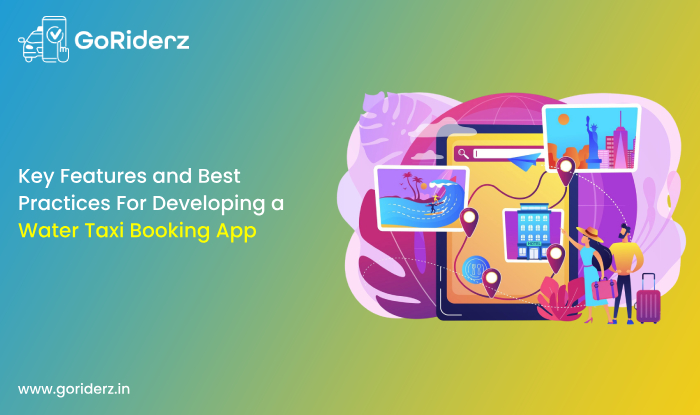
Key Features and Best Practices For Developing a Water Taxi Booking App
Table of Contents
Developing a water taxi booking app requires balancing convenience with the unique demands of aquatic transport. In water taxi booking app development, focus on seamless integration of location services and real-time updates to match user needs on rivers or coastal routes. Similarly, boat booking app development extends this to broader vessels, emphasizing reliability over land-based alternatives.
The ride-hailing services market is projected to grow at a CAGR of 7.97% starting in 2025. (IMARC)
Which Core Features Drive User Engagement?
Modern ferry booking platforms are designed to improve convenience and efficiency for both passengers and operators. Essential functionalities that form the backbone of a water taxi booking app include:
Location-Based Booking Tools
These tools revolutionize user interaction by harnessing GPS and real-time data to deliver precise, waterway-tailored experiences. These features enable seamless route planning, accounting for tides and weather, fostering trust and repeat engagement among commuters and tourists alike.
- Integrate GPS for precise pickup points along waterways.
- Offer route mapping with tide and weather overlays to inform decisions.
Payment and Scheduling Options
These options streamline the booking process by offering flexible, secure transactions and automated planning. These tools accommodate diverse users, from quick harbor hops to scheduled charters, boosting efficiency and satisfaction through seamless integrations and recurring setups.
- Support multiple gateways, including contactless, for quick marina transactions.
- Enable recurring bookings for commuters on fixed ferry lines.
Some other key features include:
| Feature Category | Purpose in Water Taxi Use | Boat Booking Extension |
| Real-Time Tracking | Monitor vessel arrival times | Adjust for larger group capacities |
| Multi-Language Support | Cater to tourists | Include vessel specs for charters |
| Offline Mode | Handle spotty coastal signals | Cache route data for remote areas |
These elements ensure the app feels intuitive, reducing drop-offs during peak usage.
The ferries segment captured over 35% of the market in 2024 and is anticipated to exceed USD 11 billion by 2034. (Global Market Insights)
How Do You Prioritize User-Centric Design in Development?
A seamless user experience is crucial for ferry booking and navigation apps. This hinges on clarity amid variable conditions like changing water levels.
Intuitive Interface Adjustments
This prioritizes accessibility amid dynamic waterway settings, ensuring effortless navigation for all users. By adapting to touch, voice, and environmental cues, these tweaks minimize errors and enhance immersion, turning complex bookings into frustration-free experiences.
- Use large, thumb-friendly buttons for on-board scanning.
- Implement voice commands for hands-free reservations during navigation.
Feedback Loops for Refinement
This empowers continuous improvement by capturing user insights post-journey. These mechanisms analyze ratings and behaviors to fine-tune personalization, such as eco-route suggestions, ensuring the app evolves with real-world usage for sustained engagement.
- Collect in-app ratings post-ride to tweak algorithms.
- Personalize notifications based on past routes, like suggesting eco-friendly options.
Which Best Practices Streamline the Development Process?
Efficient workflows prevent common pitfalls in this specialized field.
- Agile Iteration: Release beta versions to select user groups for iterative feedback.
- Cross-Platform Compatibility: Build with frameworks like Flutter to cover iOS and Android without duplication.
- Scalability Planning: Design backend for surge handling during events like regattas.
- Vendor Integration: Link with port authorities for automated berth assignments.
Conclusion
Water taxi booking app development and boat booking app development demand a mix of tailored features, thoughtful design, and robust security to serve diverse users effectively. By addressing these areas, developers create tools that not only facilitate rides but also enhance the overall journey on water. The result is an app that users return to, turning one-off bookings into loyal habits.
FAQs
What differentiates water taxi booking apps from standard ride-hailing services?
Water taxi apps incorporate waterway-specific elements like tide predictions, dock validations, and vessel tracking, unlike urban car services focused on roads and traffic.
How long does boat booking app development typically take?
It varies by scope, but core builds often span 4-6 months with a small team, including design, coding, and initial testing phases.
Can open-source tools accelerate development?
Yes, libraries for mapping, payments, and UI frameworks like React Native cut initial coding time significantly, enabling faster prototyping and deployment.
How do you handle seasonal demand fluctuations?
Through dynamic pricing modules, predictive caching for high-traffic periods, and scalable cloud infrastructure to balance loads during peak tourism seasons.
What role does testing play in launch readiness?
Extensive field tests on water ensure the app performs under real environmental stresses, catching bugs and optimizing for reliability before public release.